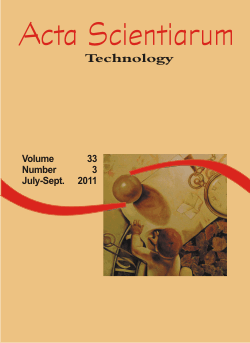<b>The efficiency of a sistem of anaerobic reactors treating swine wastewater</b> - doi: 10.4025/actascitechnol.v33i3.7941
DOI:
https://doi.org/10.4025/actascitechnol.v33i3.7941Keywords:
Biogas, anaerobic process, ABR, UASB, swine manureAbstract
Great attention has been given by environmental agencies concerning swine raising, due to the high pollutant potential of this type of activity. The challenge of Brazilian farmers is to produce, in an intensive form, high quality meat that is environmentally sustainable at the same time. Therefore, anaerobic treatment systems, such as those surveyed in this work, have gained attention in large-scale production. In this research, the installed units were: static screen (SS), equalization acidification tank (EAT), anaerobic baffled reactor (ABR), an upflow anaerobic sludge blanket reactor (UASB), and a sedimentation tank. The treatment system showed the following values of efficiency: 91.50, 85.24, 80.46, 81.34, 79.15, 23.20 and 70.28% in the removal of BOD5, CODtotal, total solids, fixed solids, volatile solids, total phosphorus, and oil & greases, respectively. The RAC and UASB reactors worked with a HRT of 15.4 and 9.7 hours, respectively. The hydraulic loading rate (HLR) was 1.57 m3 m-3 day-1 for the ABR, and 2.5 m3 m-3 day-1 for the UASB reactor; volumetric loading rate (VLOR) of 4.46 m3 m-3 day-1 for the ABR, and 1.77 m3 m-3 day-1 for the UASB reactor. The average biogas production of the UASB reactor, measured through a gasmeter, was 437.08 L day-1.Downloads
Download data is not yet available.
Downloads
Published
2011-03-17
How to Cite
Pereira, E. L., Campos, C. M. M., Moterani, F., & Oliveira Neto, A. M. de. (2011). <b>The efficiency of a sistem of anaerobic reactors treating swine wastewater</b> - doi: 10.4025/actascitechnol.v33i3.7941. Acta Scientiarum. Technology, 33(3), 287–293. https://doi.org/10.4025/actascitechnol.v33i3.7941
Issue
Section
Chemical Engineering
License
DECLARATION OF ORIGINALITY AND COPYRIGHTS
I Declare that current article is original and has not been submitted for publication, in part or in whole, to any other national or international journal.
The copyrights belong exclusively to the authors. Published content is licensed under Creative Commons Attribution 4.0 (CC BY 4.0) guidelines, which allows sharing (copy and distribution of the material in any medium or format) and adaptation (remix, transform, and build upon the material) for any purpose, even commercially, under the terms of attribution.
Read this link for further information on how to use CC BY 4.0 properly.











8.png)




